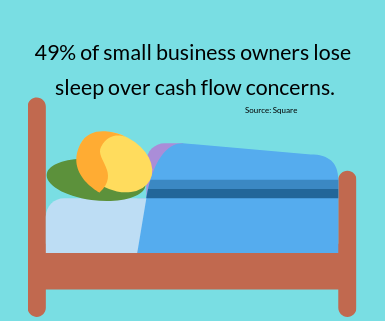Trouble Communicating Value to Your Small Business Members? Here's Why.
One of the challenges that I think a lot of chambers face in communicating with their small business audience is that most chamber staff have never owned a small business. It can be difficult to fully understand the member experience if you’ve never been in their situation. But to communicate effectively, you have to rise to the occasion. You must make an effort to understand their perspective.
What keeps them up at night? What do they struggle with?
According to Fast Company, the top four worries small business owners have are: growing revenue, hiring employees, government regulations and cash flow. The one that keeps them up at night is cash flow. A survey by Square found that 49 percent of small business owners lose sleep over cash flow concerns.You need to keep that in mind. They're losing sleep because they're concerned about their business’ ability to succeed.49% - that's almost half.So while you're talking about your next great event or promoting a program or service, if you're not taking that into consideration, you're not even coming close to connecting with these members.You have to meet them where they are and you have to understand what they're going through and how hard it is to own a business.Their concerns distract them. They haunt them. But the thing is, they're all in your wheelhouse. There is crossover between what they worry about and what your chamber is doing. And, you can connect those dots for them with communication.
The one that keeps them up at night is cash flow. A survey by Square found that 49 percent of small business owners lose sleep over cash flow concerns.You need to keep that in mind. They're losing sleep because they're concerned about their business’ ability to succeed.49% - that's almost half.So while you're talking about your next great event or promoting a program or service, if you're not taking that into consideration, you're not even coming close to connecting with these members.You have to meet them where they are and you have to understand what they're going through and how hard it is to own a business.Their concerns distract them. They haunt them. But the thing is, they're all in your wheelhouse. There is crossover between what they worry about and what your chamber is doing. And, you can connect those dots for them with communication.
Small Business Challenges
To help me illustrate my point, I would like to tell you a story about a friend of mine, Randy.Randy owns a local coffee shop. He left a career in auto body repair to pursue his dream of owning the coffee shop. Randy and his business partner, Ryan, opened their shop in 2009. It's small, just nine tables. They have 10 employees and a drive through window.I want you to think about something, because you have small business members who are just like Randy.How many cups of coffee do you think that Randy has to sell in a day to meet his payroll, to pay the rent and all of the other expenses that are involved in running a coffee shop?  Randy was kind enough to tell me. It takes 100 customers a day at an average purchase of six dollars per customer for Randy and Ryan to pay all of the bills plus payroll.That's a lot of java. So much so, that the first three years of the business, Randy and Ryan worked six days a week, ten hours a day and took no salary.3 years. 6 days a week. 10 hours a day. No salary. Let that sink in for a minute.I know you've got coffee shops, other restaurants and retail shops that are having the same experience growing their business as Randy and Ryan.They have a certain amount of money they need to make every day to keep their businesses open. It creates a lot of stress and it takes a lot of time. It’s hard work to own a business.It's so hard, that according to the SBA, 90 percent of small businesses fail within the first five years of being in business.3 years. 6 days a week.10 hours a day. No salary.Do the math. Do you think that your members who are in the same situation as Randy and Ryan were when they started their business have time to attend events? Of course not!Would attending events help them grow their business? Maybe. But none of us can be in two places at once, can we?3 years. 6 days a week.10 hours a day. No salary.Your small business members are telling you they don't have time. They really don't have time. They're wearing a lot of hats. They have their hands in everything connected to their business.Some of them are doing everything or almost everything. They're doing the marketing. They're doing the bookkeeping. They're on the sales floor. If they have a restaurant, they may be cooking.They’re exhausted. They don't have the bandwidth to attend events and take advantage of all of the services and programs that you offer that require them to show up at a certain time on a certain day.Not only can they not attend events, but when small business owners are this busy, it's hard for them to see beyond day-to-day operations to appreciate the greater role of the chamber - aka, the big picture.
Randy was kind enough to tell me. It takes 100 customers a day at an average purchase of six dollars per customer for Randy and Ryan to pay all of the bills plus payroll.That's a lot of java. So much so, that the first three years of the business, Randy and Ryan worked six days a week, ten hours a day and took no salary.3 years. 6 days a week. 10 hours a day. No salary. Let that sink in for a minute.I know you've got coffee shops, other restaurants and retail shops that are having the same experience growing their business as Randy and Ryan.They have a certain amount of money they need to make every day to keep their businesses open. It creates a lot of stress and it takes a lot of time. It’s hard work to own a business.It's so hard, that according to the SBA, 90 percent of small businesses fail within the first five years of being in business.3 years. 6 days a week.10 hours a day. No salary.Do the math. Do you think that your members who are in the same situation as Randy and Ryan were when they started their business have time to attend events? Of course not!Would attending events help them grow their business? Maybe. But none of us can be in two places at once, can we?3 years. 6 days a week.10 hours a day. No salary.Your small business members are telling you they don't have time. They really don't have time. They're wearing a lot of hats. They have their hands in everything connected to their business.Some of them are doing everything or almost everything. They're doing the marketing. They're doing the bookkeeping. They're on the sales floor. If they have a restaurant, they may be cooking.They’re exhausted. They don't have the bandwidth to attend events and take advantage of all of the services and programs that you offer that require them to show up at a certain time on a certain day.Not only can they not attend events, but when small business owners are this busy, it's hard for them to see beyond day-to-day operations to appreciate the greater role of the chamber - aka, the big picture.
So, what’s a chamber to do?
When you are planning communications for your small business audience, take events off the table for a moment, and think about those questions I mentioned earlier.What keeps them up at night? What do they struggle with? Growing revenue. Hiring employees. Government regulations. Cash flow.Beyond events, how is your chamber helping ease these struggles for your small business members?
Connect the Dots with Communication
Will recent economic development activity result in more local jobs? If yes, then connect the dots between more jobs and more money being spent in the local economy. If your chamber is involved in tourism promotion, make sure you are communicating the economic impact of tourism spending in your community. How do your small business members stand to benefit from your workforce development activities?Are you clearly communicating specific "wins" in your advocacy efforts? Saying you are the voice of business, isn't enough. Get specific in a way that helps them understand that what you are doing applies to them.
